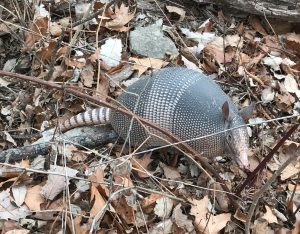Little Armored Ones
Many of us have seen them in the past few years, but usually dead on the road. The nine-banded armadillos continue to move north into southern Illinois and we have observed them at both White Rock Nature Preserve and Paul Wightman Subterranean Nature Preserve.
Armadillo, in Spanish “little armored ones,” are, except for their soft belly, covered in a tough, leathery armored shell. They have long noses, short legs with sharp clawed toes, (five back and usually four front) and long tails. The nine-banded armadillos get their name from the nine movable bands separated by flexible skin at their midsection.
Armadillos are the only living mammals that wear shells. Their closest living relatives are sloths and anteaters. Who would have guessed?
The nine-banded armadillos are the only species occurring in the U.S. They have poor eyesight but a keen sense of smell, which they use to find their food. Even though they have short legs, they can move rather quickly and can swim. By swallowing air, they increase their buoyancy and can hold their breath for up to six minutes in the water.

Being mammals, armadillos give birth to live young. The nine-banded armadillos give birth to four identical quadruplets. They have the unique ability to delay development in the uterus for up to a year if conditions are not favorable for giving birth. Young armadillos are soft and leathery when born but harden within a few weeks. They are weened around 3 months old.
The main food source for armadillos are insects including grubs, ants, beetles and termites. They will also eat earthworms and infrequently small reptiles, fungi or fruit.
If you don’t like moles in your yard, you will not like armadillos either, as they use their sharp claws to dig and root around looking for food and digging burrows.
Armadillos are solitary animals, only interacting to breed. They live in burrows dug with their sharp claws. Dense brush and woodlands near creeks or rivers are favored by armadillos. They sleep about 16 hours a day and are active at dusk and dawn. In the winter, they may come out during the warm part of the day. Their life-span averages about 8-10 years and they weigh 8-18 pounds.
They are primarily moving north due to the lack of predators like mountain lions, black bears and alligators. Their unusual ability to jump 3-4 feet straight up when scared may help them escape normal predators, but has led to their demise on the roadways.
The body temperature and metabolic rate of the armadillo are low, making it susceptible to the bacteria that causes leprosy. Although they can transmit leprosy to humans, the risk is very low.
When you are in Monroe County, be sure to watch for live armadillos. These prehistoric-looking critters are a thrill to see.
CLIFFTOP, a local nonprofit organization, is focused on preserving and protecting area blufflands.
A version of this article appeared in the May 19, 2021 edition of the Republic-Times.
©2021 all content rights reserved Clifftop NFP
Comments are currently closed.
